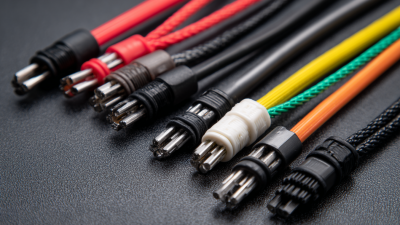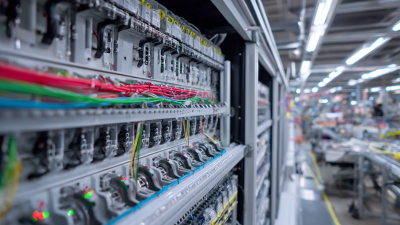In today's fast-paced manufacturing landscape, the role of electrical harness assembly has become increasingly vital in driving production efficiency. This intricate process involves the systematic organization and connection of various electrical components, ensuring that they work seamlessly together within a system. As industries evolve and the complexity of electronic devices increases, the importance of a well-designed electrical harness cannot be overstated. It not only facilitates smoother assembly but also enhances the overall reliability of the final product. In this blog, we will delve into five compelling reasons why investing in electrical harness assembly is essential for optimizing production efficiency, from reducing assembly time to minimizing the risk of errors that can lead to costly setbacks. Understanding the integral role of electrical harness assembly can empower manufacturers to achieve greater operational success and maintain a competitive edge in their respective markets.

In today's fast-paced manufacturing environment, minimizing production downtime is vital for maintaining efficiency and profitability. Electrical harness assembly plays a crucial role in this process by streamlining assembly operations and ensuring seamless connectivity between components. A well-designed harness reduces the risk of errors during installation, allowing manufacturers to keep their production lines moving smoothly.
Tip: Invest in high-quality materials for your electrical harnesses. Using durable components can significantly reduce the likelihood of failures or malfunctions, which often lead to costly downtimes. Regular maintenance and inspections can also help identify potential issues before they disrupt production.
Another key aspect of electrical harness assembly is the organization it brings to intricate layouts. By consolidating numerous wires and connections into a single unit, manufacturers can reduce clutter and make troubleshooting easier. This efficiency not only speeds up assembly but also enhances overall safety in the workplace.
Tip: Implement a standardized labeling system for your harnesses. This practice allows for quick identification of connections, making it easier for technicians to address issues swiftly and effectively, minimizing downtime during repairs or modifications.

In today's manufacturing landscape, enhancing product quality through precision electrical harnessing has become increasingly vital. The integration of digital tools and automation in the electrical harness assembly process allows manufacturers to streamline operations and minimize errors. By employing advanced technologies, companies can improve the reliability of their products, ensuring that every component is assembled with precision. This not only elevates product quality but also significantly boosts production efficiency.

Tips for enhancing electrical harness assembly include investing in automated systems, such as robotics, which can reduce manual labor and increase accuracy. Additionally, utilizing digital twin technology can help manufacturers simulate real-world conditions to optimize production processes. Regular training for your workforce on the latest technological advancements is also crucial for maintaining high standards in quality and efficiency.
As industries evolve, the importance of precise electrical harnessing will continue to grow. By making strategic investments in technology and training, manufacturers can position themselves for better product integrity and operational success. Embracing these innovations can lead to smarter production solutions and a more resilient supply chain.
Efficient electrical harness assembly can significantly impact production costs, offering substantial savings that are critical in today’s competitive market. According to a recent report by the Society of Automotive Engineers (SAE), companies that implement optimized assembly processes can reduce their overall production expenses by up to 20%. This reduction is primarily achieved through streamlined operations and decreased labor costs. For manufacturers, this means not only a leaner operation but also the ability to allocate resources more effectively, further driving down costs.
Additionally, data from the IPC (Association Connecting Electronics Industries) indicates that improving assembly efficiency can reduce material waste by approximately 15%. With rising material costs, minimizing waste is essential for maintaining profitability. Implementing high-quality electrical harness assemblies ensures that complex wiring systems are not only easier to install but also more reliable, ultimately leading to fewer returns and warranty claims. This holistic approach not only saves money but also enhances production timelines, allowing companies to respond swiftly to market demands.
In the manufacturing sector, ensuring safety standards is paramount, and one significant factor that contributes to this is the proper installation of electrical harnesses. Electrical harness assemblies are intricate systems designed to organize and protect electrical wires and components in machinery. When installed correctly, these harnesses not only streamline production processes but also significantly minimize the risk of electrical hazards. By providing a well-structured framework for wiring, they help prevent short circuits and overloads, which can lead to serious accidents and equipment failures.
Furthermore, the integration of high-quality electrical harnesses enhances the overall safety environment within production facilities. Properly assembled harnesses are less prone to wear and tear, reducing the likelihood of insulation failure that could expose workers to electrical shocks. Additionally, a well-laid-out wiring system supports clearer maintenance protocols, allowing technicians to quickly identify and resolve issues without unnecessary disruptions. In an industry where efficiency and safety go hand-in-hand, investing in proper electrical harness installation is not just a regulatory compliance measure; it's a critical component of fostering a safe and productive workplace.
Integrated wiring solutions play a crucial role in streamlining production processes, ensuring that your electrical harness assembly functions efficiently. One of the key advantages of using integrated wiring is the reduction of clutter and potential points of failure. By consolidating multiple wires into a single assembly, manufacturers can minimize installation time and reduce the risk of errors during assembly. This leads to quicker build cycles and ultimately enhances overall productivity.
Tip: Invest in design software that allows for precise planning of your wiring harness layout. This can help visualize the entire assembly process, enabling you to identify potential bottlenecks or inefficiencies early on.
Furthermore, integrated wiring solutions can contribute to significant cost savings. When wiring is streamlined, the need for additional components is reduced, which lowers material costs. Additionally, the labor involved in installation decreases, which can lead to substantial savings over time.
Tip: Regularly evaluate your wiring assemblies for potential upgrades or redesigns. Keeping your systems updated with the latest technologies can enhance performance and further streamline your production processes.
| Reason | Description | Impact on Production Efficiency | Example of Integration |
|---|---|---|---|
| Streamlined Assembly | Simplifies the assembly process by reducing the number of individual wires. | Reduces assembly time and labor costs. | Pre-assembled harnesses for automotive production lines. |
| Improved Reliability | Minimizes the risk of errors through standardized connections. | Enhances product quality and decreases return rates. | Use in aerospace systems to ensure safety and performance. |
| Space Efficiency | Consolidates wiring into a single assembly, maximizing space. | Allows for more compact designs and lighter products. | Compact harnesses used in consumer electronics. |
| Enhanced Safety | Reduces exposure to electrical hazards through protected wiring. | Minimizes risk of short circuits and electrical fires. | Safety certifications for industrial equipment using harnesses. |
| Cost Efficiency | Lower costs associated with sourcing and managing bulk wiring. | Decreases overall production costs significantly. | Mass production of wiring harnesses for several product types. |








